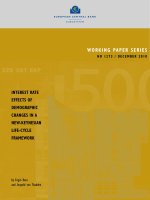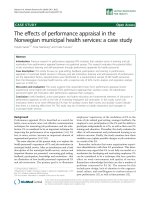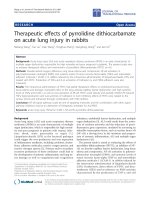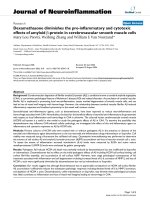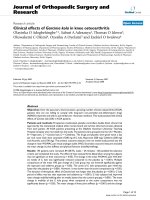Rapid Effects of Inhaled Corticosteroids in Acute Asthma | Website Bệnh viện nhi đồng 2 - www.benhviennhi.org.vn ICS in ASTHMA
Bạn đang xem bản rút gọn của tài liệu. Xem và tải ngay bản đầy đủ của tài liệu tại đây (811.13 KB, 19 trang )
Rapid Effects of Inhaled Corticosteroids
in Acute Asthma
Gustavo J. Rodrigo, MD
WWW.chestjournal.org
Background: Current reviews on the use of
inhaled corticosteroids (ICS) for acute
asthma underestimated their early clinical
impact
Objective: The analysis of the best evidence
available on the early (1 to 4 h) clinical
impact of ICS for patients with acute asthma
in the emergency department (ED).
METHODS
Included studies met the following criteria:
(1) Target population: children (6 months 17 years old) and adults (≥ 18 years old)
with acute exacerrbations of asthma ,all
study participants had a clinical
diagnosis of acute asthma
(2) Design: randomized controlled trials
conducted in an ED
(3)Intervention: ICS compared / placebo
or SCS
(4)Primary – outcomes : admission and
ED discharge rates.
Secondary-outcomes ( from 1-4h)
+spirometric measures ( PEF , FEV1 )
+clinical symptoms
+heart and respiratory rates
+oxygen saturation
+side effects
Results:
-fifty initial articles and 17 of these
randomized,
double-blind,
placebocontrolled studies (470 adults and 663
children )
+8 studies compared ICSs /placebo
+3 studies compared ICSs + SCSs/SCSs
+6 studies compared ICSs / SCSs
-ICS doses used in the trials ranged from
400 μg to 2 mg dispensed by inhaler
or nebulizer : budesonide (8 studies)
fluticasone (3)
, beclomethasone (3),
flunisolide (2), dexamethasone (1)
-“Multiple-dose” protocols administered ≥
3 doses of ICS at ≤ 30 minute intervals
(“single-dose” ≤2 doses at ≤30-minute
intervals or ≥1 dose at >30-minute
intervals.)
-Patients treated with ICS also displayed a
faster clinical improvement compared with
placebo or SCS , early ED discharge (OR,
4.70; 95% CI, 2.97 to 7.42; p = 0.0001).
-The advantage of ICS was also demonstrated
in spirometric and clinical measures < 60
min.
-These benefits were obtained only when
patients received multiple doses of ICS + β
agonists compared with placebo or SCS.
Admission rate
-A greater reduction was
observed when all trials that used
multiple doses ICS were
pooled(OR, 0.30; 95% CI, 0.16 to
0.55; I2 0%), especially when ICS
were compared with placebo.
Discharge Rate
-Six studies (545 patients) examined the
discharge rates after 2 to 3 h of treatment, a
significantly greater proportion of ICS-treated
patients were discharged from the ED
compared with either placebo or with SCS
-Patients who received multiple doses of
ICS had 4.7 times greater odds to be
discharged (95% CI, 2.97 to 7.42).
SPIROMETRY
-The seven trials that reported PEF a
significant improvement in PEF/ ICS
treatment
-There was a dose response relation -ship ;
the greater benefit when patients were
treated with multiple doses of ICS.
-Patients treated with ICS showed pooled
WMD in PEF of 25, 35, and 46L/min at 60,
120, and 180 min .
-Similar results were obtained for FEV1 ,
Pooled WMDs in FEV1 were 0.12 , 0.16 , 0.24
L at 60, 120, and 180 min, respectively.
-There was a significant improvements in
FEV1 / ICS treatment compared with
placebo were found at 120 min and 180 to
240 min (WMD, 0.2 L; 95% CI, 0.0 to 0.3; I2
0%; and WMD, 0.3 L; 95% CI, 0.1 to 0.5; I2
0%, respectively).
Other Outcomes
-Eight
trials
reported a significant
reduction of clinical scores after ICS
treatment / placebo and SCS.
-This reduction was dose related (WMD,
0.40; 95% CI, 0.60 to 0.20; p 0.0001, I2
12%; and WMD, 0.51; 95% CI, 0.71 to 0.31;
p 0.0001;I2 40%, at 60 ,120, 180 min)
-Finally, all studies reported that there were
no serious side effects.
CONCLUSIONS
-These studies suggest that ICS
treatment provides early beneficial
effects (1–2 hours) when they were
used in multiple-dose amounts
administered in time intervals of
≤30 minutes (multiple doses of ICS
+ β-agonists )
Implications for practice and
s
research
-This review clearly supports the use of
ICS for the treatment of children and
adults with asthma exacerbations
-Nongenomic early effect of ICS / with
acute asthma exacerbation may be
significant in the treatment of most
severe case
-The use of ICS (through an MDI and
spacer or nebulization) every 10 to 30
min and > 3 doses
could be
recommended.
-Although there was an important
variation between studies, the evidence
suggests that the minimum effective
nebulized doses for fluticasone and
budesonide would be 500 microg and
800 microg every 30 min
-These doses would have to be
administered during a minimum of 90 min,
although more prolonged periods of
administration could generate a greater
benefit.
-Nevertheless, more future studies< 5 ages,
future studies will have to clarify the
relationship between
+the dose administered
+acute asthma severity
+response to treatment
-Inhaled glucocorticosteroids can be
effective as oral glucocorticosteroids
at preventing relapses
-Patients discharged from the ED on
prednisone + ICS have a lower rate of
relapse than those on prednisone alone
-A high - dose of ICS - 2,4 mg
budesonide daily in four divided
doses- achieves a relapse rate similar
to 40mg prednisone daily
THANK YOU FOR YOUR
ATTENTION AND
LISTENING
